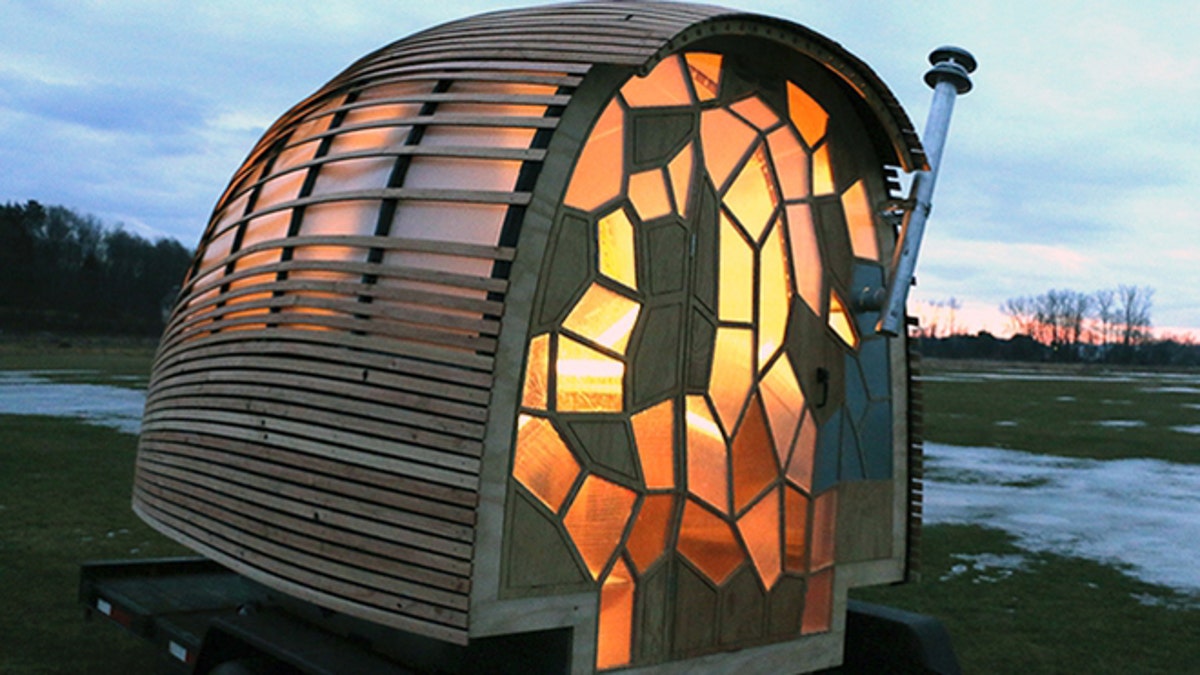
Made by 16 college kids from Vermont, the OTIS pod home features a rainwater collection system for indoor plumbing and stained-glass like privacy windows. It can also be towed by a four-cylinder vehicle. (Green Mountain College)
Last month 16 students from a tiny college in Vermont built a tiny house that took off in a big, big way.
The 70-square-foot half dome was designed to be towed aerodynamically on a 5-by-8-foot trailer hitched to a four-cylinder vehicle. Looking like an outhouse converted into a cathedral, the pod-shaped home collects and filters rainwater for indoor plumbing and is powered by a 120-watt solar panel system. And it has a composting toilet that handles the … well, you know. (And it isn’t gross at all, really!)
It’s a resourceful, charming and tech-savvy design, and it might not have happened were it not for the miniaturized gadgets we’ve fallen in love with over the last decade.
“The evolution of tiny houses has paralleled the digital revolution, since this whole tiny thing started at the turn of the century,” Jay Shafer of Four Lights Tiny House Company told FoxNews.com. “Once it became possible to have a remote little phone instead of a landline, and a wall-mounted flat screen instead of a 2-foot-by-1-foot chunk on the dresser, folks started seeing the potential for living in what basically amounts to a laptop with a roof.”
But while innovations such as energy-efficient mini-fridges, compact washers and dryers and the above amenities enable us to live in tiny houses, low-tech is just as important when it comes to building them.
“Aside from small solar panels being affixed to tiny homes for gadget-charging and the like, the movement is actually more about a return to the low-tech, grandparent-approved basics,” said Matt Hickman, an architectural writer for the Mother Nature Network.
That means things like propane stoves, tiny wood-burning fireplaces, garden hoses for water hook-ups and the aforementioned composting toilets. “I think the do-it-yourself, low-tech appeal of tiny homes paired with financial and mobility freedom have contributed to the rise in tiny homes,” Hickman said.
But tiny homes are just a fad for hippies, a niche housing craze for Walden-inspired hipsters that will never go mainstream. Right?
Going mainstream isn’t the point, Hickman said. “The McMansion isn't going anywhere, but I think more and more Americans will continue to take interest in what's being called right-sizing. This doesn't mean we'll see an uptick in folks selling everything, going off the grid and moving into extremely small mobile homes. It’s more about gradual downsizing, reassessing all our stuff, and making housing choices that are more appropriate for modern lifestyles.”
That’s certainly been the case in my own life. In designing a home recently, my wife and I decided on a considerably smaller floor plan than normal, despite our oversized family of seven (five kids). We did this specifically to avoid the added maintenance and attention more square footage demands.
Comedian Jim Gaffigan is even more extreme. Despite his commercial success and seeming ability to live in much larger digs, he resides in a two-bedroom apartment in lower Manhattan with his wife and five children.
Millennials, too, in addition to forsaking cars and driving licenses, are especially fond of the less-is-more movement. But even if every home isn’t as tiny as the kind Shafer and many others build, their high-tech-meets-low-tech ethos is undeniably a driving factor of diminishing home sizes.
“If tiny houses aren't the wave of the future, they're definitely a big ripple on the wave,” Shafer said. “A lot of people are tired of being shoehorned into more space than they need. As long as that continues to be the case, this small house thing seems destined to get bigger.”
Blake Snow is a content writer and adviser from Provo, where he lives with his family.




















